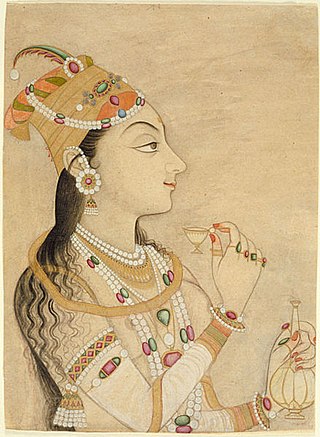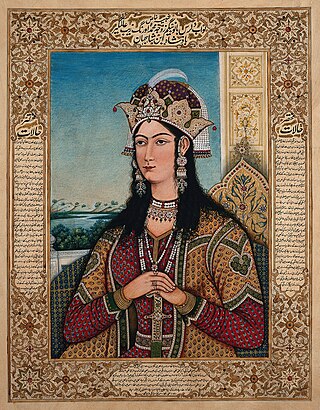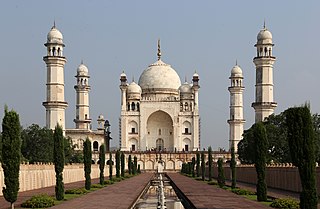Related Research Articles

Mirza Shahab-ud-Din Muhammad Khurram, also known as Shah Jahan I, was the fifth Mughal emperor, reigning from 1628 until 1658. During his reign, the Mughals reached the peak of their architectural and cultural achievements.

Mumtaz Mahal was the empress consort of Mughal Empire from 1628 to 1631 as the chief consort of the fifth Mughal emperor, Shah Jahan. The Taj Mahal in Agra, often cited as one of the Wonders of the World, was commissioned by her husband to act as her tomb.

Nur Jahan, born Mehr-un-Nissa was the twentieth wife and chief consort of the Mughal emperor Jahangir.
The Taj Mahal is a mausoleum in Agra, India, built by Mughal Emperor Shah Jahan.

Mughal architecture is the type of Indo-Islamic architecture developed by the Mughals in the 16th, 17th and 18th centuries throughout the ever-changing extent of their empire in the Indian subcontinent. It developed from the architectural styles of earlier Muslim dynasties in India and from Iranian and Central Asian architectural traditions, particularly Timurid architecture. It also further incorporated and syncretized influences from wider Indian architecture, especially during the reign of Akbar. Mughal buildings have a uniform pattern of structure and character, including large bulbous domes, slender minarets at the corners, massive halls, large vaulted gateways, and delicate ornamentation; examples of the style can be found in modern-day Afghanistan, Bangladesh, India and Pakistan.

Tomb of I'timād-ud-Daulah is a Mughal mausoleum in the city of Agra in the Indian state of Uttar Pradesh. Often described as a "jewel box", sometimes called the "Bachcha Taj" or the "Baby Taj", the tomb of I'timād-ud-Daulah is often regarded as a draft of the Taj Mahal.

Taj Mahal: An Eternal Love Story is a 2005 Indian historical drama film directed by Akbar Khan. The film starred Kabir Bedi, Sonya Jehan, Manisha Koirala, Arbaaz Khan, Vaquar Shaikh, Rahil Azam and Pooja Batra in the title roles. The film was released on 18 November in India.

Indo-Islamic architecture is the architecture of the Indian subcontinent produced by and for Islamic patrons and purposes. Despite an initial Arab presence in Sindh, the development of Indo-Islamic architecture began in earnest with the establishment of Delhi as the capital of the Ghurid dynasty in 1193. Succeeding the Ghurids was the Delhi Sultanate, a series of Central Asian dynasties that consolidated much of North, East, and Central India, and later by the Mughal Empire during the early 16th century. Both of these dynasties introduced Islamic architecture and art styles from West Asia into the Indian subcontinent.

Mirza Ghiyas Beg, also known by his title of I'timad-ud-Daulah, was an important official in the Mughal Empire, whose children served as wives, mothers, and generals of the Mughal emperors.

The Bibi Ka Maqbara is a tomb located in the city of Aurangabad in the Indian state of Maharashtra. It was commissioned in 1660 by the Mughal emperor Aurangzeb's son prince Azam Shah in the memory of his loving mother Dilras Banu Begum. It bears a striking resemblance to the Taj Mahal, the mausoleum of Aurangzeb's mother, Mumtaz Mahal and that is why it is also called the Taj of the Deccan. Aurangzeb was not much interested in architecture though he had commissioned the small, but elegant, Moti Masjid at Delhi. Bibi Ka Maqbara is the second largest structure that Aurangzeb has built, the largest being the Badshahi Mosque.

The Culture of Uttar Pradesh is an Indian culture which has its roots in Hindi, Bhojpuri and Urdu literature, music, fine arts, drama and cinema. Lucknow, the capital of Uttar Pradesh, has historical monuments including Bara Imambara and Chhota Imambara, and has preserved the damaged complex of the Oudh-period British Resident's quarters, which are being restored.

Abhishek Sharma, popularly known by his screen name Krushna Abhishek, is an Indian actor, comedian and television host from Mumbai, Maharashtra. He is notable for his humours work in comedy shows on Indian television such as Comedy Circus, Comedy Nights Bachao and The Kapil Sharma Show.

Dilras Banu Begum was the first wife and chief consort of Emperor Aurangzeb, the sixth Mughal emperor. She is also known by her posthumous title, Rabia-ud-Durrani. The Bibi Ka Maqbara in Aurangabad, which bears a striking resemblance to the Taj Mahal, was commissioned by her husband to act as her final resting place.

Abu'l-Hasan entitled by the Mughal emperor Jahangir as Asaf Khan, was the Grand Vizier of the fifth Mughal emperor Shah Jahan. He previously served as the vakil of Jahangir. Asaf Khan is perhaps best known for being the father of Arjumand Banu Begum, the chief consort of Shah Jahan and the older brother of Empress Nur Jahan,And The Maternal Grandfather Of Mughal Emperor Aurangzeb
Ruqaiya Sultan Begum was the first wife and one of the chief consorts of the third Mughal emperor, Akbar.

Sayyid Ahmedullah Qadri, known as Lisan-ul-Mulk, was a writer, author, critic, editor-in-chief, Indian independence activist, Indian politician and an acclaimed figure of Hyderabad, India. He was president of Lutfuddaulah Oriental Research Institute Hyderabad, president of Hyderabad Journalist Association, member of State Library Council.

Persian Inscriptions on Indian Monuments is a book written in Persian by Dr Ali Asghar Hekmat E Shirazi and published in 1956 and 1958 and 2013. New edition contains the Persian texts of more than 200 epigraphical inscriptions found on historical monuments in India, many of which are currently listed as national heritage sites or registered as UNESCO world heritage, published in Persian; an English edition is also being printed.
Brij Khandelwal of Agra is a well known journalist and environmentalist.
Siyaasat is a 2014 Indian fictional drama which aired on The EPIC Channel. The series is an adaptation of the popular 2002 award-winning fictional novel The Twentieth Wife by author Indu Sundaresan.

'Ataullah Rushdi bin Ahmad Ma'mar was a 17th-century architect and a mathematics writer from the Mughal Empire of present-day India. He designed the Bibi Ka Maqbara at Aurangabad and some buildings at Shahjahanabad. As a mathematics writer, he translated the Arabic-language Khulasat al-Hisab and the Sanskrit-language Bijaganita into Persian.
References
- ↑ "Retired post office clerk builds his own 'Taj Mahal'". Rediff.com . 31 August 2015.
- ↑ Ledbetter, Carly (11 November 2014). "7 Other Taj Mahals That Look Extremely Similar To The Original". HuffPost.
- ↑ Haleem, Suhail (23 July 2013). "Indian builds a Taj Mahal for his wife". BBC.
- ↑ Khandelwal, Peeyush (21 August 2015). "This retired UP postmaster built a Taj Mahal for his 'Mumtaz'". Hindustan Times.
- ↑ "A humble Indian postman builds a Taj Mahal for his wife". No. 8 December 2014. The National.
- ↑ "Small wonder: Indian postmaster builds own 'Taj Mahal' for late wife". The Express Tribune. 21 August 2015.
- ↑ "OMG! बीवी की याद में बनवा दिया ताजमहल" (in Hindi). News 18. 6 July 2017.
- ↑ "Uttar Pradesh Government to Help Retired Man Build 'Mini' Taj Mahal in Bulandshahr". NDTV. 22 August 2015.
- ↑ Kapur, Manavi (29 August 2015). "Faizul Hasan Qadri is building a 'Taj Mahal'". Business Standard.
- ↑ "Meet today's Shah Jahan, who's building new Taj Mahal". Zee News. 20 August 2015.
- ↑ "In his journey of love, UP Muslim man surrenders his 'Taj Mahal' dream to build girls' school". OneIndia . 24 June 2017.
- ↑ Khandelwal, Peeyush (24 June 2017). "Now a school for girls next to Bulandshahr's 'Taj Mahal', thanks to this retired postmaster". Hindustan Times.
- ↑ "In his journey of love, UP Muslim man surrenders his 'Taj Mahal' dream to build girls' school". OneIndia . 24 June 2017.
- ↑ "Mini Taj Mahal maker for wife dies in a road accident". The Sentinel. 10 November 2018.
- ↑ "'Mini Taj' maker Faizul Hasan Qadri dies in accident; to be buried next to his Begum in his 'monument'". The Financial Express (India). 10 November 2018.
- ↑ "Qadri's Taj Mahal". History TV18. 2 November 2016.